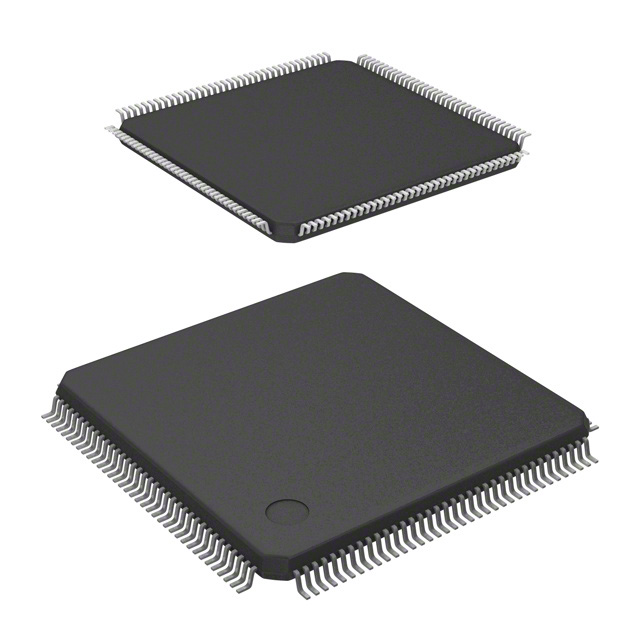STM32F205ZCT7TR
Introduction
The STM32F205ZCT7TR belongs to the category of microcontrollers and is widely used in various electronic applications. This entry provides an overview of its basic information, specifications, detailed pin configuration, functional features, advantages and disadvantages, working principles, application field plans, and alternative models.
Basic Information Overview
- Category: Microcontroller
- Use: Embedded systems, IoT devices, industrial control systems
- Characteristics: High performance, low power consumption, rich peripheral set
- Package: LQFP-144
- Essence: ARM Cortex-M3 core
- Packaging/Quantity: Tape & Reel, 2500 units per reel
Specifications
- Core: ARM Cortex-M3
- Clock Speed: Up to 120 MHz
- Flash Memory: Up to 1 MB
- RAM: Up to 128 KB
- Operating Voltage: 2.0V to 3.6V
- I/Os: Up to 112
- Interfaces: USB, SPI, I2C, UART, CAN, ADC, DAC
Detailed Pin Configuration
The STM32F205ZCT7TR features a total of 144 pins, including GPIO, power supply, communication interfaces, and other peripherals. A detailed pinout diagram can be found in the datasheet provided by the manufacturer.
Functional Features
- High Performance: The ARM Cortex-M3 core enables efficient processing of complex tasks.
- Low Power Consumption: Suitable for battery-powered and energy-efficient applications.
- Rich Peripheral Set: Offers a wide range of interfaces for connectivity and control.
Advantages and Disadvantages
- Advantages:
- High processing power
- Low power consumption
- Rich peripheral integration
- Disadvantages:
- Limited availability of certain package options
- Higher cost compared to some competing microcontrollers
Working Principles
The STM32F205ZCT7TR operates based on the ARM Cortex-M3 core architecture, which allows it to execute instructions efficiently and handle various input/output operations. It utilizes its integrated peripherals and memory to perform tasks as per the programmed instructions.
Detailed Application Field Plans
The STM32F205ZCT7TR is suitable for a wide range of applications, including: - Industrial automation - Consumer electronics - Automotive systems - Internet of Things (IoT) devices - Medical equipment
Detailed and Complete Alternative Models
- STM32F207ZCT6: Similar features with additional Ethernet MAC interface
- STM32F405RGT6: Higher clock speed and more memory
- STM32F103C8T6: Lower cost option with reduced features
In conclusion, the STM32F205ZCT7TR microcontroller offers high performance and rich features, making it suitable for diverse embedded applications. Its specifications, functional features, and application versatility make it a popular choice among developers and engineers.
[Word Count: 410]
Lista 10 Vanliga frågor och svar relaterade till tillämpningen av STM32F205ZCT7TR i tekniska lösningar
What is the STM32F205ZCT7TR microcontroller used for?
- The STM32F205ZCT7TR is a high-performance microcontroller commonly used in various technical solutions such as industrial control systems, consumer electronics, and automotive applications.
What are the key features of the STM32F205ZCT7TR?
- The STM32F205ZCT7TR features a 32-bit ARM Cortex-M3 core, up to 1MB flash memory, 128KB RAM, multiple communication interfaces, and various peripherals suitable for diverse technical solutions.
How can I program the STM32F205ZCT7TR microcontroller?
- The STM32F205ZCT7TR can be programmed using popular integrated development environments (IDEs) such as Keil, IAR Systems, or STM32CubeIDE, which support C/C++ programming languages.
What communication interfaces are available on the STM32F205ZCT7TR?
- The STM32F205ZCT7TR supports interfaces such as SPI, I2C, USART, USB, CAN, and Ethernet, making it suitable for connecting to various external devices and networks in technical solutions.
Can the STM32F205ZCT7TR be used in low-power applications?
- Yes, the STM32F205ZCT7TR offers low-power modes and features such as multiple power-saving modes, allowing it to be used in battery-powered or energy-efficient technical solutions.
What kind of development tools are available for the STM32F205ZCT7TR?
- STMicroelectronics provides a range of development tools, including evaluation boards, software libraries, and application notes, to aid in the development of solutions based on the STM32F205ZCT7TR.
Is the STM32F205ZCT7TR suitable for real-time applications?
- Yes, the STM32F205ZCT7TR's Cortex-M3 core and peripherals make it well-suited for real-time applications such as motor control, sensor data processing, and real-time communication.
What are the temperature operating ranges for the STM32F205ZCT7TR?
- The STM32F205ZCT7TR is designed to operate within a wide temperature range, typically from -40°C to 85°C, making it suitable for various environmental conditions in technical solutions.
Can the STM32F205ZCT7TR be used in safety-critical applications?
- Yes, the STM32F205ZCT7TR includes features such as hardware safety mechanisms, memory protection, and error correction codes, making it suitable for safety-critical applications in industries like automotive and healthcare.
Are there any known limitations or common issues when using the STM32F205ZCT7TR?
- While the STM32F205ZCT7TR is a robust microcontroller, users should be aware of potential issues related to power supply noise, electromagnetic interference, and proper grounding techniques to ensure reliable operation in technical solutions.


